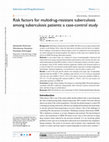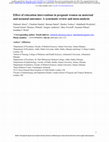Papers by Abdulhalik Workicho

Neuropsychiatric Disease and Treatment, Aug 1, 2022
Background: Cognition is one of the most complex functions of the human brain, and major neurocog... more Background: Cognition is one of the most complex functions of the human brain, and major neurocognitive disorders affect this function causing a wide array of problems in an individual's life. Screening for major neurocognitive disorders can be helpful in designing and implementing early interventions. Purpose: This study was designed to assess the reliability and validity of the Montreal Cognitive Assessment (MoCA) tool to detect major neurocognitive disorders among older people in Ethiopia. Methods: One hundred and sixteen randomly selected older adults in Ethiopia were involved in a cross-sectional study. The Diagnostic and Statistical Manual of Mental Disorders criteria for major neurocognitive disorders was used as a gold standard. Data were analyzed using STATA v16 statistical software. Receiver operating curve analysis was performed, and inter-rater, internal consistency reliabilities, content, criterion and construct validities were determined. Statistically significance was declared at a p-value of <0.05. The study had a 100% response rate. The mean age of the study participants was 69.87 ± 7.8. The inter-rater reliability value was 0.96, and Cronbach's alpha was 0.79. The optimal cutoff value was ≤21, and Montreal Cognitive Assessment has an area under curve value of 0.89. The sensitivity, specificity, positive and negative likelihood ratios, and positive and negative predictive values of MoCA are 87.18%, 74.03%, 3.35, 0.17, 63%, and 91.9%, respectively. The tool also has good concurrent and construct validities. The Montreal Cognitive Assessment tool was a reliable and valid tool to detect major neurocognitive disorder. It can be incorporated into the clinical and research practices in developing countries.
Research Square (Research Square), Nov 11, 2022

Infection and Drug Resistance, Mar 1, 2017
Background: Multidrug-resistant tuberculosis (MDR-TB) did not receive major attention until recen... more Background: Multidrug-resistant tuberculosis (MDR-TB) did not receive major attention until recently in sub-Saharan Africa where the tuberculosis incidence and risk factors are highest. Factors leading to development of drug resistance need to be understood to develop appropriate control strategies for national programs. The objective of this study was to identify the risk factors for MDR-TB among tuberculosis patients. Methods: A case-control study was conducted to assess sociodemographic, behavioral and clinical risk factors using a structured questionnaire and clinical record reviewing. The data were entered and analyzed using SPSS windows version 16. Descriptive analysis was done to generate summary values for the variables and those significant variables in the bivariate analysis at p-value less than 0.25 were entered to multivariable logistic regression to identify independent determinants. Statistical significance was declared at p-value less than or equal to 0.05. Results: A total of 90 cases and 90 controls were included in the study. Age of respondents (adjusted odds ratio [AOR] =7; 95% confidence interval [CI]: 2.6-24.5), living in a household with only one room (AOR=5; 95%CI: 1.68-15.38), history of previous treatment (AOR=21; 95% CI: 17.8-28) and being HIV infected (AOR=3.1; 95%CI: 1.02-9.4) were found to be independent predictors of MDR-TB. In light of these findings, the strategies in controlling MDR-TB should emphasize on patients with HIV coinfection, young patients, those who have a history of previous treatment, and those living in crowded places.
Journal of Clinical and Experimental Cardiology, 2017
Medical Practice and Reviews, Jan 31, 2018

Objectives: Knowledge, attitude, and practice gaps of cardiovascular disease risk factors are sig... more Objectives: Knowledge, attitude, and practice gaps of cardiovascular disease risk factors are significant obstacles to prevention and care. This study assessed the magnitude of cardiovascular diseases’ risk factors and public knowledge, attitude, and practice towards it in Jimma town, southwest Ethiopia. Methods: A Community based cross-sectional study was conducted in Jimma town southwest Ethiopia, from November 1 to 28, 2021. A multi-stage sampling technique was utilized to get a total sample size of 332. All Jimma town individuals of age 18 years or above who fulfilled inclusion criteria were included. The data were collected using an interviewer-administered structured questionnaire. Data entry was done by Epidata, version 3.2 software and analysed with SPSS, version 26. Results: About 56.4% of the participants had good knowledge of cardiovascular disease risk factors. They had a poor attitude toward cardiovascular disease risk factors. About 70.2% didn’t do moderate intensity a...

BMJ open diabetes research & care, Feb 1, 2019
What is already known about this subject? ► The WHO and International Diabetic Federation recomme... more What is already known about this subject? ► The WHO and International Diabetic Federation recommended that HRQOL measurement as a major interventional outcome, and ► HRQOL and associated factors in several studies were focused on overall HRQOL. What are the new findings? ► All dimensions of HRQOL among patients with diabetes in this study setting were compromised. ► All domains of HRQOL were inversely associated with duration of disease, age of patients and fasting blood sugar. ► This study identified specific factors for each domain in addition to overall HRQOL. ► This study revealed that body mass index and number of complications are inversely associated with overall HRQOL. How might these results change the focus of research or clinical practice? ► This finding provides insight to focus on HRQOL for measure of interventions among patients with non-curative diseases. ► This finding will improve client-physician communication. ► The results of this study provide information to decision makers and program planners that will help develop, monitor, and evaluate treatment strategies and existing treatment guidelines for patients with type II diabetes.

Ethiopian medical journal, Jan 19, 2024
Policy development is a complex and iterative process with multiple stages involving multiple sta... more Policy development is a complex and iterative process with multiple stages involving multiple stakeholders and demanding resources. In the health system, problems of various nature, often requiring evidence, trigger the policy development process. Evidence Informed Policy Making (EIPM) is believed to increase the credibility, effectiveness, efficiency, equity, trustworthiness, and acceptability of policies and interventions (1). It also facilitates a more efficient use of scarce resources in health care, reduces research waste, and improves transparency and accountability (2, 3). Hence, the interface between evidence and policy-making in the health system is becoming increasingly important. Ideally, the policy-making process would base on scientific evidence and through participating all stakeholders. But of course, scientific evidence is not the only consideration in policy decisions. Contrary to its depiction, the pathway to EIPM in the health system, in fact, in any other sector, is generally non-linear (4).
Nutrition and dietary supplements, Feb 1, 2020
journal of cardio-thoracic medicine, Dec 1, 2019

PLOS ONE
Background Ethiopia has undergone rapid economic growth over the last two decades that could infl... more Background Ethiopia has undergone rapid economic growth over the last two decades that could influence the diets and nutrition of young people. This work systematically reviewed primary studies on adolescent nutrition from Ethiopia, to inform future interventions to guide policies and programs for this age group. Method A systematic search of electronic databases for published studies on the prevalence of and interventions for adolescent malnutrition in Ethiopia in the English language since the year 2000 was performed using a three-step search strategy. The results were checked for quality using the Joanna Bridge Institute (JBI) checklist, and synthesized and presented as a narrative description. Results Seventy six articles and two national surveys were reviewed. These documented nutritional status in terms of anthropometry, micronutrient status, dietary diversity, food-insecurity, and eating habits. In the meta-analysis the pooled prevalence of stunting, thinness and overweight/o...

BackgroundMaternal stress during pregnancy has been associated with adverse pregnancy and birth o... more BackgroundMaternal stress during pregnancy has been associated with adverse pregnancy and birth outcomes. Aiming to reduce maternal stress and to improve pregnancy and birth outcomes, different relaxation interventions have been tested during pregnancy. This systematic review and meta-analysis was conducted on studies that have tested relaxation interventions to improve maternal wellbeing, and pregnancy and birth outcomes in various settings.MethodA systematic search of PubMed, EMBASE Classic + EMBASE (Ovid), MEDLINE In-Process and Non-Indexed Citations, MEDLINE Daily, and MEDLINE (Ovid), Cumulative Index to Nursing & Allied Health Plus (CINAHL via EBSCO) and Cochrane library databases was conducted to identify studies on stress reduction relaxation interventions in pregnant women. The outcomes of interest were maternal mental health (stress, anxiety, and depression), pregnancy outcomes (gestational age, labor duration and mode of delivery) and birth outcomes (birth weight, APGAR sc...

Pediatric Health, Medicine and Therapeutics
Background: Globally, more than 19 million children have not received all of their vaccination be... more Background: Globally, more than 19 million children have not received all of their vaccination benefits, resulting in an estimated one million deaths worldwide each year. Vaccine-preventable diseases are becoming more common in Ethiopia, despite the fact that official vaccination coverage is sufficient to develop herd immunity locally for some diseases such as measles. This mistrust of the official report prompted us to conduct a community survey and compare it to other areas where there have been no reports of vaccinepreventable disease. Methods: A community-based comparative cross-sectional study was conducted from 20/01-20/02/2021 in Sinana and Mettu districts. Probability proportional to estimate size was used to select 23 clusters. We recruited 228 from Mettu and 436 from Sinana by systematic random sampling. We used a structured questionnaire to collected data from mother-child pair using card and history. We conducted independent t-tests to test coverage differences between districts. We identified determinants of full vaccination status by multivariate logistic regression analysis after bivariate candidate selection. Results: Fully vaccinated children accounted for 62.7% in Sinana and 91.6% in Mettu, demonstrating a significant coverage difference (p<0.001). Being a resident of Mettu (AOR: 3.5, 95% CI [1.5, 6.9]), intended pregnancy (AOR 5.9, 95% CI [2.4, 11.3]), 4 or more antenatal care visits (AOR: 2.09, 95% CI [1.4, 3]), having postnatal care (AOR: 3.5, 95% CI [1.6, 7.9]), younger child age (AOR: 0.87, 95% CI [0.8, 0.9]), having up to three children (AOR 3, 95% CI [1.13, 8]) and good knowledge of vaccine schedule (AOR: 2.4, 95% CI [1.4, 4]) were associated positively with full vaccination status. Conclusion: Full vaccination status was 91.6% in Mettu and 62.7% in Sinana district. Place of residence, ANC, PNC, pregnancy intention, child number, age of child and knowledge of vaccination schedule were significantly associated with vaccination status of the children.

PLOS ONE
Background The Rowland Universal Dementia Assessment Scale (RUDAS) is currently widely used for r... more Background The Rowland Universal Dementia Assessment Scale (RUDAS) is currently widely used for research and clinical purposes in many countries. However, its applicability and validity have not been evaluated in the Ethiopian context so far. Therefore, we designed this study to assess the reliability and validity of Rowland Universal Dementia Assessment Scale to detect major neurocognitive disorder among older people in Ethiopia. Methods An institution-based cross-sectional study was conducted among selected older people residing in Macedonia institutional care center, Addis Ababa, Ethiopia. The gold standard diagnosis was determined using the Diagnostic and Statistical Manual of Mental Disorders criteria for major neurocognitive disorders. Stata v16 statistical software was used for data analysis. Receivers operating curve analysis, correlations, linear regression, and independent t-test were performed with statistically significant associations declared at a p-value of <0.05. ...
This data set contains the minimal data required to replicate the analysis and findings of the st... more This data set contains the minimal data required to replicate the analysis and findings of the study titled "Validation of the Rowland's Universal Dementia Assessment Scale (RUDAS) to detect major neurocognitive disorder among elderly people in Ethiopia, 2021"
Estimates table for the linear, quadratic and cubic-spline models. (DOCX 16 kb)










Uploads
Papers by Abdulhalik Workicho